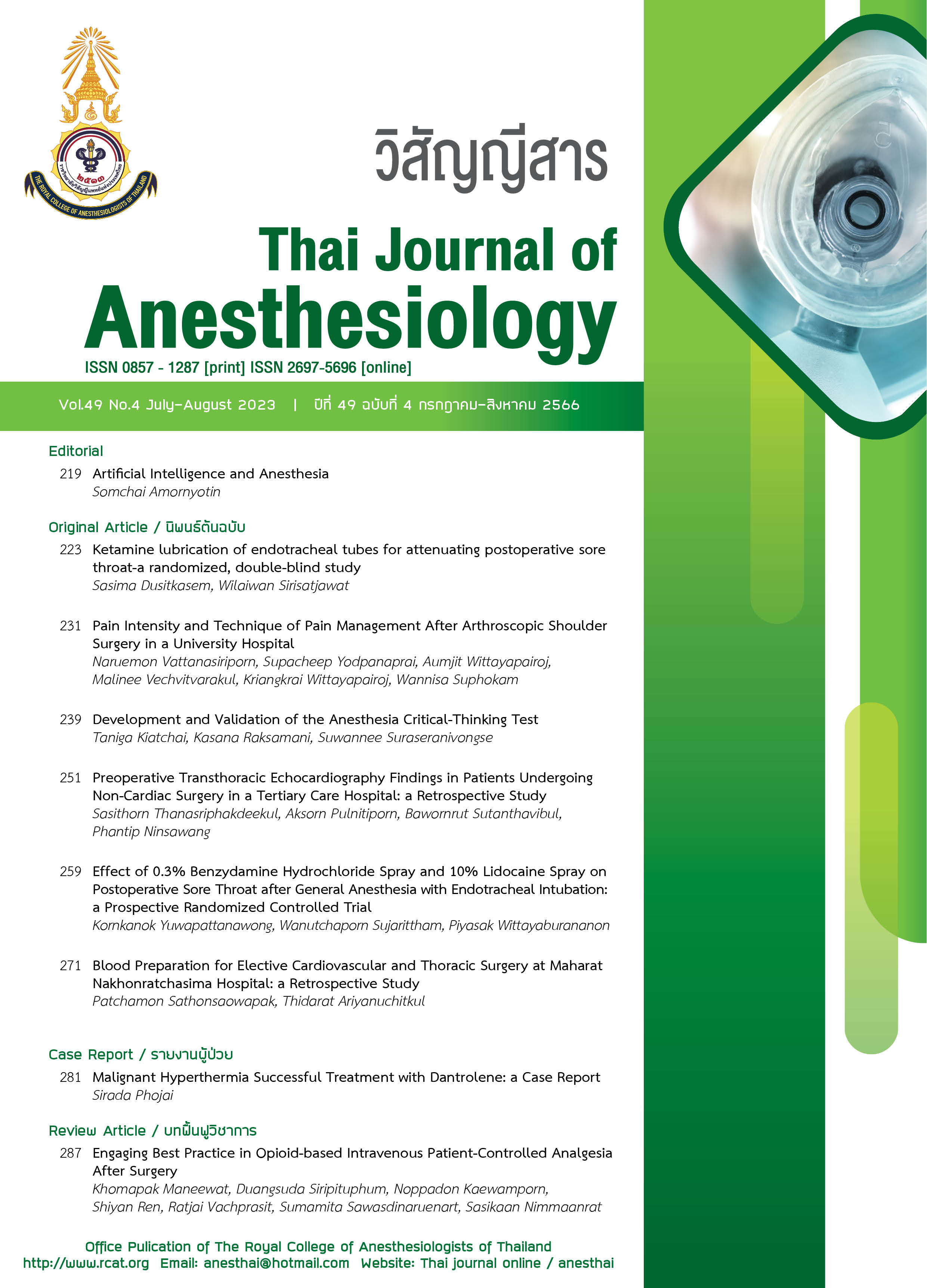Effect of 0.3% Benzydamine Hydrochloride Spray and 10% Lidocaine Spray on Postoperative Sore Throat after General Anesthesia with Endotracheal Intubation: a Prospective Randomized Controlled Trial
Main Article Content
Abstract
Background: Postoperative sore throat (POST) is the most common airway-related complication after endotracheal extubation. POST has an affect on patient’s satisfaction. The objective of the study is to compare the effects of 0.3% benzydamine hydrochloride spray and 10% lidocaine spray on postoperative sore throat score in first 24 hour after general tracheal anesthesia, and to compare the side effects including hoarseness, cough, dysphagia, and nausea/vomiting after general anesthesia. Methods: This study was a prospective randomized controlled trial. A total of 165 patients was randomly allocated into 3 groups. Group A 0.3% benzydamine hydrochloride spray (n=56), group B 10% lidocaine spray (n=54) and group C normal saline solution (n=55) was applied to the cuffed endotracheal tube before intubation. Patients were examined for postope-rative sore throat score, hoarseness, cough, dysphagia and nausea/vomiting at 1, 6, 12 and 24 hours after extubation. Results: 0.3% benzydamine hydrochloride spray and 10% lidocaine spray could decrease postoperative sore throat in first 24 hour after surgery but there was not significantly different between groups (A/B, A/C, and B/C) at 1, 6, 12 and 24 hours after extubation. With 10% lidocaine spray, coughing was observed at 1 h after extubation (P=0.019). With 0.3% benzydamine hydrochloride spray, nausea/vomiting was observed at 6 h after extubation (P=0.015). Conclusion: 0.3% benzydamine hydrochloride spray, 10% lidocaine spray and normal saline solution applied to endotracheal cuff tube can reduce postoperative sore throat in first 24 hour after tracheal extubation. However, 0.3% benzydamine hydrochloride spray and 10% lidocaine spray could not prevent hoarseness and dysphagia after extubation.
Article Details

This work is licensed under a Creative Commons Attribution-NonCommercial-NoDerivatives 4.0 International License.
References
Tanaka Y, Nakayama T, Nishimori M, Tsujimura Y, Kawaguchi M, Sato Y. Lidocaine for preventing postoperative sore throat. Cochrane Database Syst Rev. 2015;CD004081.
Agarwal A, Nath SS, Goswami D, Gupta D, Dhiraaj S, Singh PK. An evaluation of the efficacy of aspirin and benzydamine hydrochloride gargle for attenuating postoperative sore throat: a prospective, randomized, single-blind study. Anesth Analg. 2006;103:1001-3.
Jaensson M, Gupta A, Nilsson UG. Risk factors for development of postoperative sore throat and hoarseness after endotracheal intubation in women: a secondary analysis. AANA J. 2012;80(Suppl):S67-73.
Tabari M, Soltani G, Zirak N, Alipour M, Khazaeni K. Comparison of effectiveness of betamethasone gel applied to the tracheal tube and IV dexamethasone on postoperative sore throat: a randomized controlled trial. Iran J Otorhinolaryngol. 2013;
:215-20.
Jaensson M, Olowsson LL, Nilsson U. Endotracheal tube size and sore throat following surgery: a randomized-controlled study. Acta Anaesthesiol Scand. 2010;54:147-53.
Park SH, Han SH, Do SH, Kim JW, Rhee KY, Kim JH. Prophylactic dexamethasone decreases the
incidence of sore throat and hoarseness after tracheal extubation with a double-lumen endobronchial tube. Anesth Analg. 2008;107:1814-8.
Hung NK, Wu CT, Chan SM, et al. Effect on postoperative sore throat of spraying the endo-tracheal tube cuff with benzydamine hydrochloride, 10% lidocaine, and 2% lidocaine. Anesth Analg. 2010;111:882-6.
Rudra A, Ray S, Chatterjee S, Ahmed A, Ghosh S. Gargling with ketamine attenuates the postoperative sore throat. Indian J Anaesth. 2009;53:40-3.
Minogue SC, Ralph J, Lampa MJ. Laryngotracheal topicalization with lidocaine before intubation decreases the incidence of coughing on emergence from general anesthesia. Anesth Analg. 2004;99:1253-7.
Mekhemar NA, El-agwany AS, Radi WK, El-Hady SM. Comparative study between benzydamine hydrochloride gel, lidocaine 5% gel and lidocaine 10% spray on endotracheal tube cuff as regards postoperative sore throat. Rev Bras Anestesiol. 2016;66:242-8.
Agarwal A, Nath SS, Goswami D. An evaluation of the efficacy of aspirin and benzydamine hydrochloride gargle for attenuating postoperative sore throat: a prospective, randomized, single-blind study. Anesth Analg. 2006;103:1001-3.
Navarro LHC, Braz JRC, Nakamura G, Lima RM, Silva FP, Módolo NSP. Effectiveness and safety of endotracheal tube cuffs filled with air versus filled with alkalinized lidocaine: a randomized clinical trial. Sao Paulo Med J. 2007;125:322-8.
Rosner B. Fundamentals of Biostatistics, 5th edition, Duxbury Press, Belmont, 2000.
Chari VR, Paul A. Comparative study to analyze the incidence of sore throat, cough, and hoarseness of voice after general anesthesia withthe use of topical benzydamine hydrochloride and 2% lignocaine gel with placebo. Med J DY Patil Univ. 2016;9:61-5.
Dabbagh A. Postoperative pain management in cardiac surgery. In: Dabbagh A, Esmailian F, Aranki SF, editors. Postoperative critical care for cardiac surgical patients. New York: Springer Heidelberg. 2014;p253-90.


